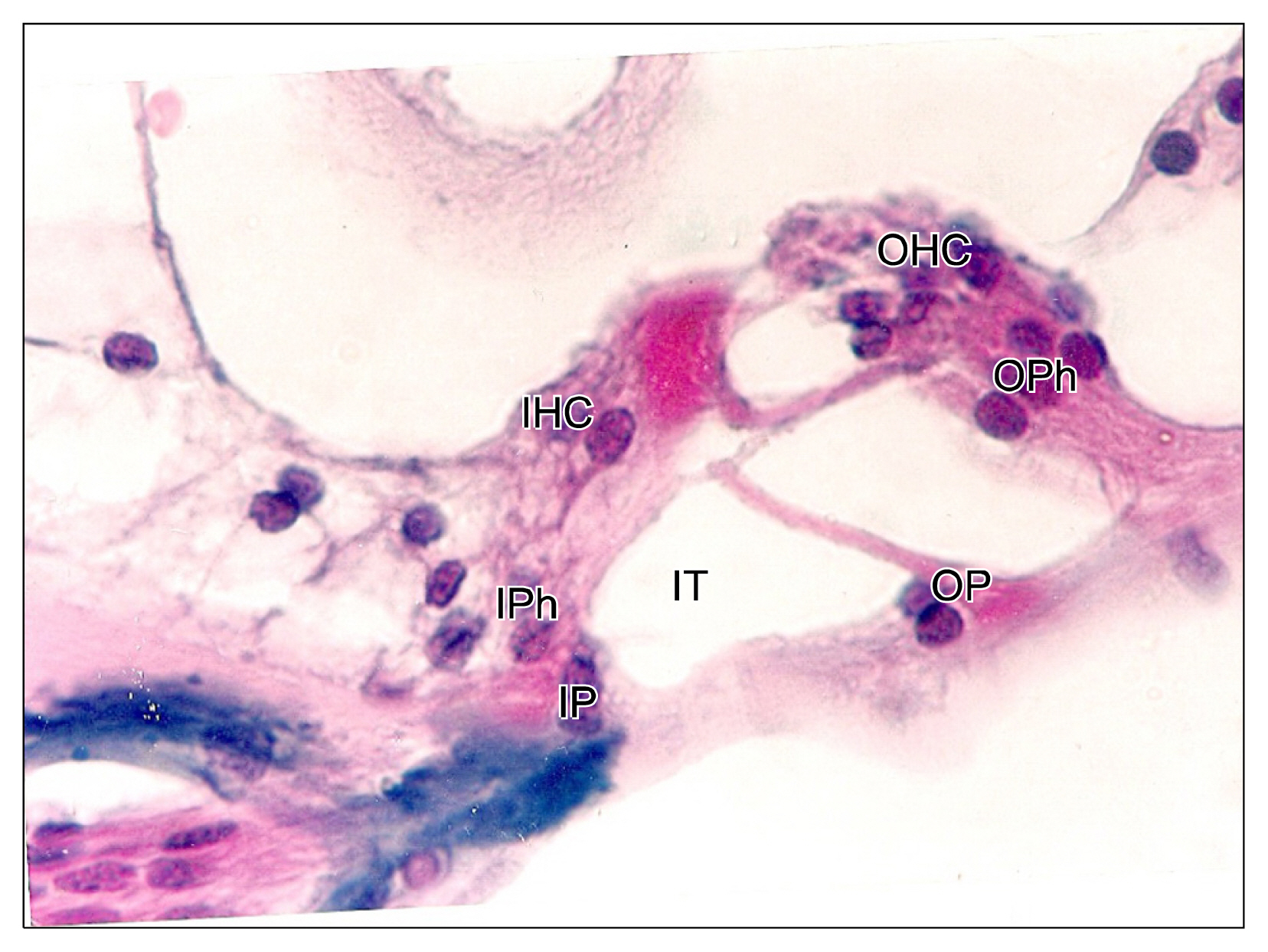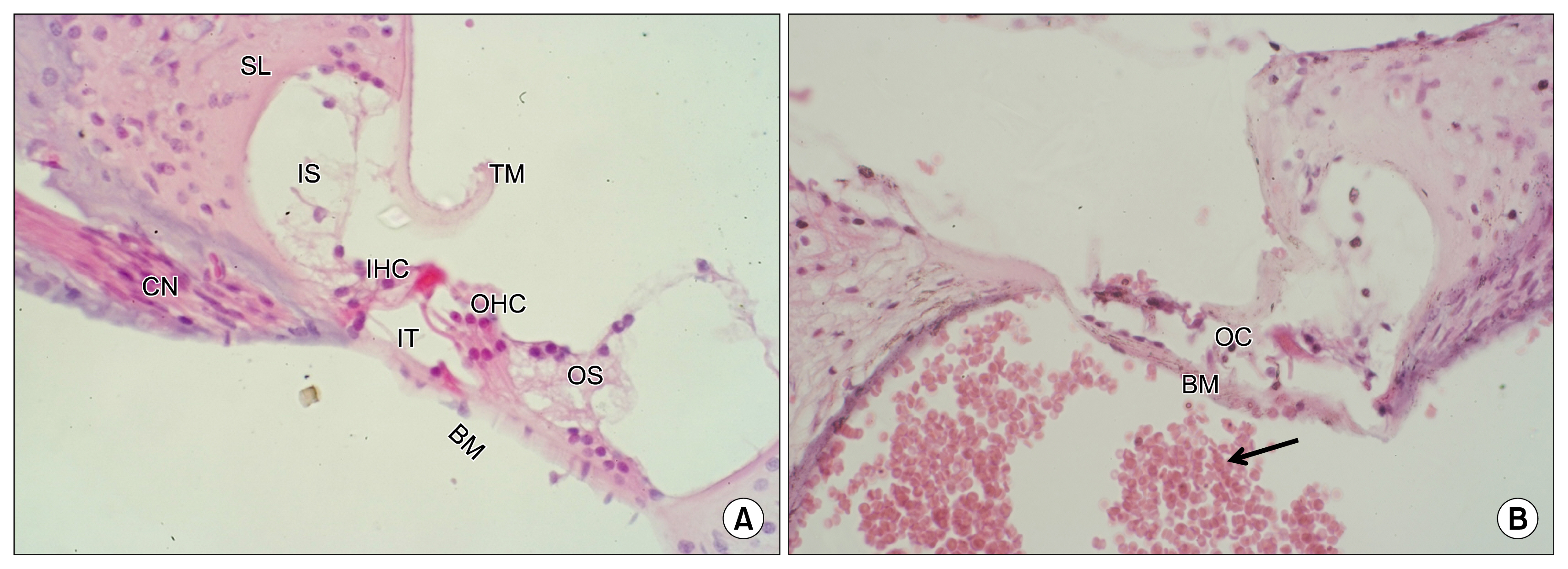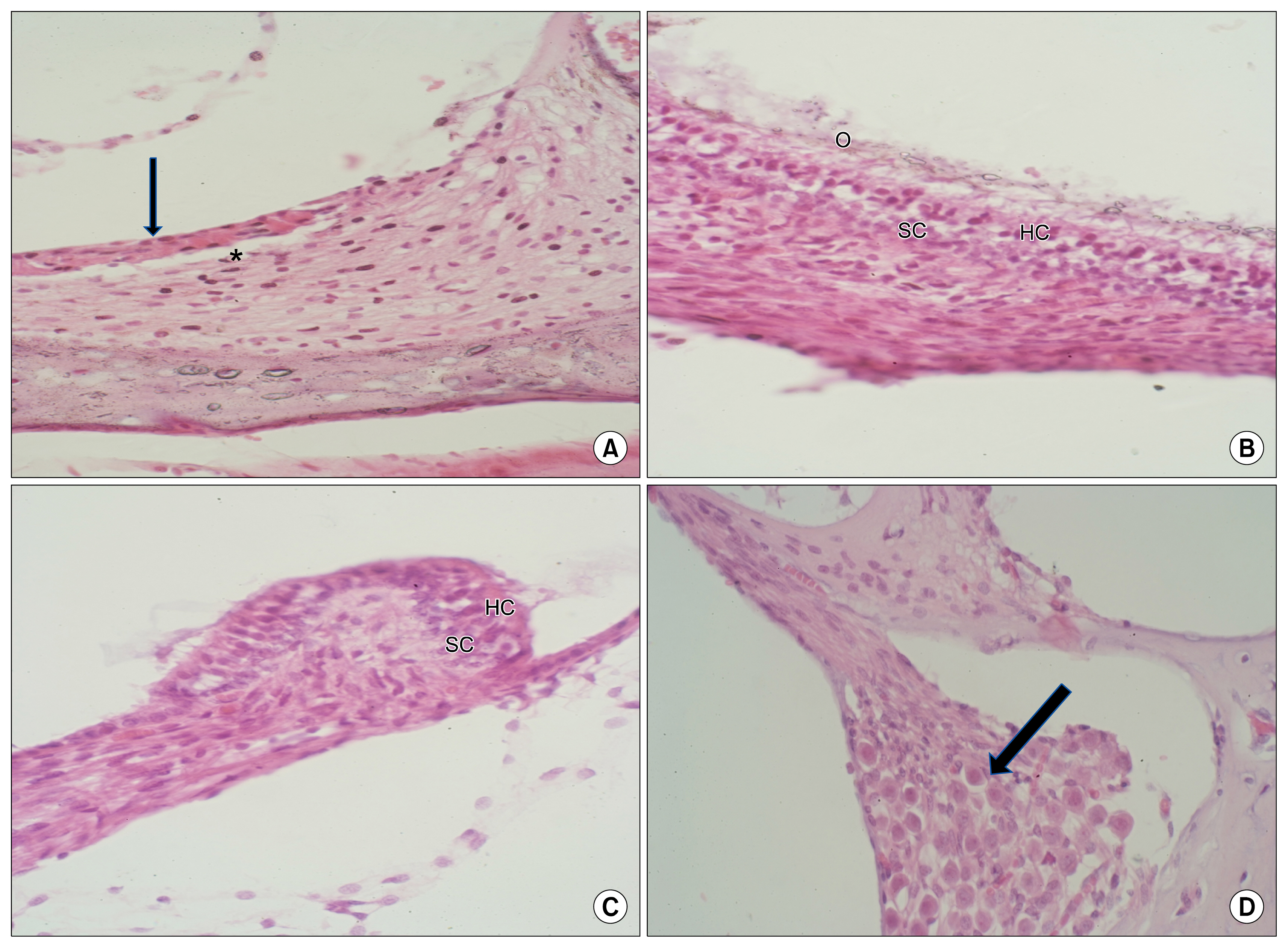Int J Stem Cells.
2015 Nov;8(2):146-154. 10.15283/ijsc.2015.8.2.146.
Role of Endogenous Bone Marrow Stem Cells Mobilization in Repair of Damaged Inner Ear in Rats
- Affiliations
-
- 1Department of ORL-H&N Surgery, Faculty of Medicine, University of Alexandria, Alexandria, Egypt. ahmedelbanna@yahoo.com
- 2Department of Histology, Faculty of Medicine, University of Alexandria, Alexandria, Egypt.
- KMID: 2380809
- DOI: http://doi.org/10.15283/ijsc.2015.8.2.146
Abstract
- BACKGROUND AND OBJECTIVES
The utilization of the stem cells is widely used in the last few years in different fields of medicine, either by external transplantation or endogenous mobilization, most of these studies still experimental on animals; few were tried on human as in the spinal cord injury or myocardial infarction. As regard its use in the inner ear, stem cell transplantation was examined in many previous studies, while the mobilization idea is a new method to be experimented in inner ear hair cell regeneration. The present work assessed the possibility of mobilizing endogenous bone marrow derived stem cells (SCs) in rats using granulocyte colony stimulating factor (G-CSF) to induce regeneration and repair to experimentally damaged inner ear hair cells by Amikacin injection.
METHODS
The study included thirty adult Sprague Dawley male rats. Experimental induction of inner ear damage was done by repeated intratympanic injection of amikacin sulfate. Mobilization of bone marrow SCs was provoked by subcutaneous injection of GCSF. Cochlear integrity, induction of hearing loss and functional recovery of sensory hearing loss were assessed using Distortion Product Otoacoustic Emission (DPOAEs). The morphological alteration and recovery of the organ of Corti was assessed histologically using the light and scanning electron microscopes.
RESULTS
After six month duration, there was improvement in 50% of the sensorineural DPOAE results. Functional recovery coincided with the repair of structural components of organ of Corti.
CONCLUSIONS
SCs mobilization by G-CSF is a promising alternative method for replacement therapy in sensorineural hearing loss.
Keyword
MeSH Terms
-
Adult
Amikacin
Animals
Bone Marrow*
Colony-Stimulating Factors
Ear, Inner*
Granulocyte Colony-Stimulating Factor
Granulocytes
Hair
Hearing
Hearing Loss
Hearing Loss, Sensorineural
Humans
Injections, Subcutaneous
Male
Myocardial Infarction
Organ of Corti
Rats*
Regeneration
Spinal Cord Injuries
Stem Cell Transplantation
Stem Cells*
Amikacin
Colony-Stimulating Factors
Granulocyte Colony-Stimulating Factor
Figure
Reference
-
References
1. Gulya AJ, Anson BJ. Anatomy of the ear and temporal bone. Shambaugh GE, Glasscock ME, editors. Surgery of the ear. 5th ed. Hamilton: B.C. Decker Inc;2003. p. 35–57.2. Gulya AJ, Schuknecht HF. Anatomy of the temporal bone with surgical implications. 2nd ed. Pearl River, NY: Parthenon Pub Inc;1995.3. Anson BJ, Donaldson JA. Surgical anatomy of the temporal bone. 3rd ed. Philadelphia: WB Saunders;1981.4. Michaels L, Hellquist HB. Ear, nose and throat histopathology. 2nd ed. London: Springer;2001. DOI: 10.1007/978-1-4471-0235-9.5. Lim DJ. Functional structure of the organ of Corti: a review. Hear Res. 1986; 22:117–146. DOI: 10.1016/0378-5955(86)90089-4. PMID: 3525482.
Article6. Weissman IL. Stem cells: units of development, units of regeneration, and units in evolution. Cell. 2000; 100:157–168. DOI: 10.1016/S0092-8674(00)81692-X. PMID: 10647940.7. Sell S. Stem cells. Stem Cell Handbook. Sell S, editor. 2004. p. 1–18.8. Blau HM, Brazelton TR, Weimann JM. The evolving concept of a stem cell: entity or function? Cell. 2001; 105:829–841. DOI: 10.1016/S0092-8674(01)00409-3. PMID: 11439179.9. Díaz-Flores L Jr, Madrid JF, Gutiérrez R, Varela H, Valladares F, Alvarez-Argüelles H, Díaz-Flores L. Adult stem and transit-amplifying cell location. Histol Histopathol. 2006; 21:995–1027. PMID: 16763950.10. Bryder D, Rossi DJ, Weissman IL. Hematopoietic stem cells: the paradigmatic tissue-specific stem cell. Am J Pathol. 2006; 169:338–346. DOI: 10.2353/ajpath.2006.060312. PMID: 16877336. PMCID: 1698791.11. Handgretinger R, Gordon PR, Leimig T, Chen X, Buhring HJ, Niethammer D, Kuci S. Biology and plasticity of CD133+ hematopoietic stem cells. Ann N Y Acad Sci. 2003; 996:141–151. DOI: 10.1111/j.1749-6632.2003.tb03242.x. PMID: 12799292.12. Wagers AJ, Christensen JL, Weissman IL. Cell fate determination from stem cells. Gene Ther. 2002; 9:606–612. DOI: 10.1038/sj.gt.3301717. PMID: 12032706.
Article13. Cohen Y, Nagler A. Umbilical cord blood transplantation--how, when and for whom? Blood Rev. 2004; 18:167–179. DOI: 10.1016/S0268-960X(03)00064-X. PMID: 15183901.14. Nagler A, Bellehsen L, Schaffer F. Stem Cells: Clinical Applications. 7th ed. Adkinson: Middleton’s Allergy;2008. p. 259–268.15. Parker MA, Corliss DA, Gray B, Anderson JK, Bobbin RP, Snyder EY, Cotanche DA. Neural stem cells injected into the sound-damaged cochlea migrate throughout the cochlea and express markers of hair cells, supporting cells, and spiral ganglion cells. Hear Res. 2007; 232:29–43. DOI: 10.1016/j.heares.2007.06.007. PMID: 17659854. PMCID: 2032013.
Article16. Demetri GD, Griffin JD. Granulocyte colony-stimulating factor and its receptor. Blood. 1991; 78:2791–2808. PMID: 1720034.
Article17. Carletons HM, Drury RAB, Willington EA. Carleton’s histological technique. 5th ed. Oxford;Oxford University Press;1980. p. 43.18. Glauert AM. Fixation, dehydration and embedding of biological specimens. 1st ed. Amsterdam, Oxford: North Holland Pub;1986. p. 111–114.19. Ito J, Kojima K, Kawaguchi S. Survival of neural stem cells in the cochlea. Acta Otolaryngol. 2001; 121:140–142. DOI: 10.1080/000164801300043226. PMID: 11349765.
Article20. Tateya I, Nakagawa T, Iguchi F, Kim TS, Endo T, Yamada S, Kageyama R, Naito Y, Ito J. Fate of neural stem cells grafted into injured inner ears of mice. Neuroreport. 2003; 14:1677–1681. DOI: 10.1097/00001756-200309150-00004. PMID: 14512836.
Article21. Li H, Liu H, Heller S. Pluripotent stem cells from the adult mouse inner ear. Nat Med. 2003; 9:1293–1299. DOI: 10.1038/nm925. PMID: 12949502.
Article22. Li H, Roblin G, Liu H, Heller S. Generation of hair cells by stepwise differentiation of embryonic stem cells. Proc Natl Acad Sci U S A. 2003; 100:13495–13500. DOI: 10.1073/pnas.2334503100. PMID: 14593207. PMCID: 263842.
Article23. Parker MA, Cotanche DA. The potential use of stem cells for cochlear repair. Audiol Neurootol. 2004; 9:72–80. DOI: 10.1159/000075998. PMID: 14981355.
Article24. Martinez-Monedero R, Oshima K, Heller S, Edge AS. The potential role of endogenous stem cells in regeneration of the inner ear. Hear Res. 2007; 227:48–52. DOI: 10.1016/j.heares.2006.12.015. PMID: 17321086. PMCID: 2020819.
Article25. Li H, Corrales CE, Edge A, Heller S. Stem cells as therapy for hearing loss. Trends Mol Med. 2004; 10:309–315. DOI: 10.1016/j.molmed.2004.05.008. PMID: 15242678.
Article26. Pellicer M, Giráldez F, Pumarola F, Barquinero J. Stem cells for the treatment of hearing loss. Acta Otorrinolaringol Esp. 2005; 56:227–232. DOI: 10.1016/S0001-6519(05)78606-4. PMID: 15999787.27. Zohlnhöfer D, Ott I, Mehilli J, Schömig K, Michalk F, Ibrahim T, Meisetschläger G, von Wedel J, Bollwein H, Seyfarth M, Dirschinger J, Schmitt C, Schwaiger M, Kastrati A, Schömig A. REVIVAL-2 Investigators. Stem cell mobilization by granulocyte colony-stimulating factor in patients with acute myocardial infarction: a randomized controlled trial. JAMA. 2006. 295:p. 1003–1010. DOI: 10.1001/jama.295.9.1003.
Article28. Kloner RA. Attempts to recruit stem cells for repair of acute myocardial infarction: a dose of reality. JAMA. 2006; 295:1058–1060. DOI: 10.1001/jama.295.9.1058. PMID: 16507807.
Article29. Schäbitz WR, Kollmar R, Schwaninger M, Juettler E, Bardutzky J, Schölzke MN, Sommer C, Schwab S. Neuro-protective effect of granulocyte colony-stimulating factor after focal cerebral ischemia. Stroke. 2003; 34:745–751. DOI: 10.1161/01.STR.0000057814.70180.17.
Article30. Shyu WC, Lin SZ, Lee CC, Liu DD, Li H. Granulocyte colony-stimulating factor for acute ischemic stroke: a randomized controlled trial. CMAJ. 2006; 174:927–933. DOI: 10.1503/cmaj.051322. PMID: 16517764. PMCID: 1405861.
Article31. Oishi A, Otani A, Sasahara M, Kojima H, Nakamura H, Yodoi Y, Yoshimura N. Granulocyte colony-stimulating factor protects retinal photoreceptor cells against light-induced damage. Invest Ophthalmol Vis Sci. 2008; 49:5629–5635. DOI: 10.1167/iovs.08-1711. PMID: 18676635.
Article32. Meuer K, Pitzer C, Teismann P, Krüger C, Göricke B, Laage R, Lingor P, Peters K, Schlachetzki JC, Kobayashi K, Dietz GP, Weber D, Ferger B, Schäbitz WR, Bach A, Schulz JB, Bähr M, Schneider A, Weishaupt JH. Granulocyte-colony stimulating factor is neuroprotective in a model of Parkinson’s disease. J Neurochem. 2006; 97:675–686. DOI: 10.1111/j.1471-4159.2006.03727.x. PMID: 16573658.
Article
- Full Text Links
- Actions
-
Cited
- CITED
-
- Close
- Share
- Similar articles
-
- Bone marrow-derived stem cells contribute to regeneration of the endometrium
- The Effect of In Vivo Mobilization of Bone Marrow Stem Cells on the Pancreas of Diabetic Albino Rats (A Histological & Immunohistochemical Study)
- Endogenous Stem Cells in the Ear
- Endogenous Stem Cells in Homeostasis and Aging
- Neural Differentiation of Bone Marrow-Derived Mesenchymal Stem Cells: Applicability for Inner Ear Therapy








